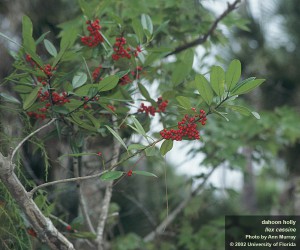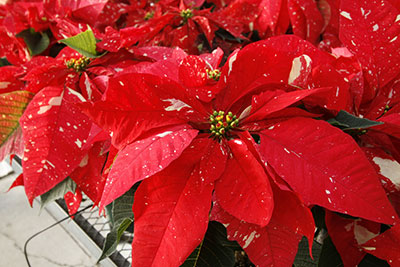 Theresa Badurek, UF/IFAS Extension, Pinellas County
Theresa Badurek, UF/IFAS Extension, Pinellas County
Over the years we have posted many holiday themed blogs, and it seems like a great time to revisit several of those helpful topics all in one convenient location. (Because we know how busy you are this time of year!) So read on to learn all about Florida holiday gardening; we’ve made a list and checked it twice…
Christmas cactus, Schlumbergera truncata, usually flowers from Thanksgiving to Christmas and its leaves have pointed lobes. The Easter cactus, Schlumbergera bridgesii, has wider leaves, which are rounded, flowers from Christmas to Easter. Allow soil to dry out between watering and keep the plant in bright light while in bloom. These are long-lived plants and can be kept outside in the shade during most of the year. These plants are also photo (light) sensitive and uninterrupted periods of dark (starting in early September) initiate the bloom. Artificial light at night from a porch, street, or window light will offset the flowering. They do need to be protected from frost and freezing temperatures. All parts of this plant are poisonous, so keep out of reach of pets and children. Click here for more information on Christmas cactus.
Cold Protection: Plant the right plant in the right place! A Floridian wouldn’t do well in North Dakota this time of year, and likewise a tropical plant won’t thrive here when the mercury drops, so be sure to plant things that are suited to our location. For plants that may not quite be suited to this location you may be able to help them by planting them in protected locations such as a south-facing area protected by walls, fences, hedges (evergreen of course), etc.
If you are going to cover your plants to protect them from frost remember that the cover should be raised above the plant and remember to remove any plastic covers on sunny days to avoid burning the plant. For more info on cold protection in the landscape: http://solutionsforyourlife.ufl.edu/hot_topics/lawn_and_garden/cold_protection_of_ornamental_plants.html
Hollies: There are several native hollies that we can grow here that provide food and habitat for our wildlife while also providing decoration both outside and in. Holly fruits are a favorite winter food for many birds and mammals, providing seasonal nutrition for our feathered and furry friends. In addition to providing a food source, holly shrubs and trees also provide habitat for many birds. While the most important benefit of these plants is enjoying them outdoors in their natural state, they can also be used as cut greens in holiday decorations (the evergreen varieties). Keep in mind that hollies are dioecious plants: the male and female flowers are on separate plants and female plants produce berries. If you are looking for berries for holiday décor you will want to make sure you have some female plants. Also, many of the dwarf varieties do not produce berries.
Hollies prefer part shade but most will tolerate full sun, they prefer acidic soils, and they all require a well-drained soil. Here are a few suggested native hollies:
- American Holly, Ilex opaca. This is the holly most traditionally associated with the holiday season. It has spiny leaves and red or yellow fruit.
- Dahoon Holly, Ilex cassine. This holly makes a great specimen or street tree and has another seasonally appropriate common name- Christmas Berry.
- Yaupon Holly, Ilex vomitoria. This can be a small shrub or a small tree.
Florida Christmas tree farms: Click here to find one near you! Buying a Florida tree supports local farmers and can provide you and your family a more traditional holiday experience. When your celebrations are done and the decorations put away, please remember to recycle your tree: http://www.pinellascounty.org/utilities/getridofit/xmas_tree_recycling.pdf
For all kinds of information about Christmas trees, both living and artificial, please visit: http://solutionsforyourlife.ufl.edu/hot_topics/families_and_consumers/christmas_trees.html#living.
Poinsettia is a traditional holiday favorite that come in a variety of colors to suit your holiday decorating needs. If your holiday Poinsettia comes in a container wrapped in a foil outer cover, remove it or punch holes in the bottom to allow excess water to drain. Keep the soil around your poinsettia slightly moist, but not soggy, and place the plant in a bright window out of direct sunlight. After the holidays these can be planted in your landscape. They are photo (light) sensitive and uninterrupted periods of dark (starting in early September) initiate the bloom. Artificial light at night from a porch, street, or window light will offset the flowering. Click here for more information on poinsettias.
Winter Gardening 101: http://pinellas.ifas.ufl.edu/home_landscape/documents/PinellasCountyWinterGardening101.pdf
Winter Veggie Gardening: Click here for a handy chart that lists what you can plant in December.
Keep in mind that if you directly plant seeds in the garden this time of year your tender new shoots may not survive if we experience frost or freeze, so you may need to provide cold protection for your winter garden during those times. Even many mature plants won’t tolerate a frost or freeze, so always keep an eye on the forecast.
If you are new to Florida vegetable gardening, or just want to learn more, you will enjoy this link to the “Florida Vegetable Gardening Guide”.
Happy Holidays!
 0
0


